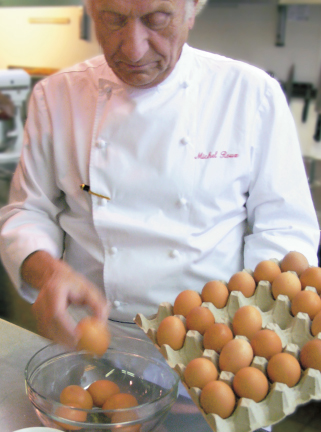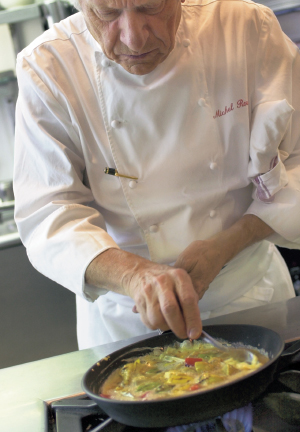
Labelling of eggs This varies from country to country. In the UK, the Lion Quality mark indicates that the egg has been produced to higher standards of hygiene and animal welfare than required by EU or UK law. All Lion Quality eggs come from British hens vaccinated against salmonella and carry a ‘best before’ date, which is 21 days after packing. An additional code on the egg indicates how the hens have been kept: 0 for organic eggs; 1 for free-range eggs; 2 for barn eggs; 3 for eggs produced by caged hens. Special breed hen’s eggs are available from many supermarkets, farmer’s markets and other specialist suppliers. These often have a denser texture, superior flavour and larger, deeper coloured yolks.
Organic and free-range eggs Organic eggs are widely available. They are produced by hens fed on natural feed (free from additives), which have freedom to roam outdoors and are kept in relatively small flocks. Free-range eggs are produced by hens that also have continuous access to outdoor runs, and a varied diet, though they are usually kept in larger flocks. I advocate the use of organic or free-range eggs, whenever possible.
Egg shell colour This varies according to the breed of chicken. American consumers favour eggs with a white shell, whereas the French and British are more inclined to prefer brown eggs. Some special breed hens produce eggs with pretty coloured shells in a range of pastel shades.
The flavour of an egg This is concentrated in the yolk and is determined by what the chicken eats – corn, wheat etc. Its rich taste is composed of many different elements. Needless to say, you cannot identify these individually when you taste an egg.
Egg sizes Hen’s eggs vary in weight from under 53g (1¾oz) for a small egg, 53 – 62g (1¾–2¼oz) for medium, 63 – 72g (2¼–2½oz) for large, and over 73g (2½oz) for very large. The only inedible part of an egg is the shell, which weighs about 9g (⅓oz). Of the edible parts of a medium egg, the white weighs about 33g (1¼oz) and the yolk approximately 20g (⅔oz).
Egg whites These are a vital ingredient in soufflés, mousses and meringues, their whisked texture lending extraordinary volume and lightness. Unlike the yolks, egg whites vary significantly according to the size of the egg. I almost always use the whites of medium eggs. If you are unsure, it is best to measure the volume of egg whites: 250 ml (1 cup) = 8 medium egg whites; 500 ml (2 cups) = 16 whites.
In many sauces, pastries and other recipes, only the egg yolks are used, and the whites are simply thrown away. This is completely unnecessary, particularly as egg whites freeze extremely well. In fact, they become more glutinous on freezing, which makes them even better for preparing meringues and soufflés.
Freshness If you are in any doubt about the freshness of an egg, do the following simple test: Drop the egg into cold salted water (100g/3½oz salt to 1 litre/4 cups water). If the egg sinks, it is ‘extra fresh’; if it remains suspended in the water, it is about 2 weeks old; if it floats, the egg is not fresh enough to be eaten and should be thrown away.
Did you know? A single hen lays around 280 eggs each year. Light, temperature and feed all affect her laying capacity. She needs at least 12 hours of light to conceive an egg and the time between conception and laying is a mere 24 – 26 hours. And finally, I should mention that a hen has no need of a male mate to produce an egg, which can be produced from a fertilised or unfertilised ovum.

At The Waterside Inn, I use free-range eggs from a local farm. They are supremely fresh, with beautiful deep yellow yolks. I recommend that you buy organic or free-range eggs whenever possible. Those labelled ‘extra fresh’ guarantee that the eggs have been laid within the past 9 days. ‘Fresh’ eggs have been laid within 28 days.

A good-quality non-stick frying pan will make all the difference when you are cooking omelettes, fried eggs, crêpes, etc. I use Tefal pans, which give excellent results at both low and high temperatures.